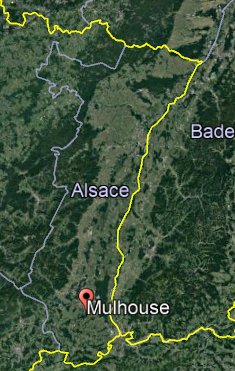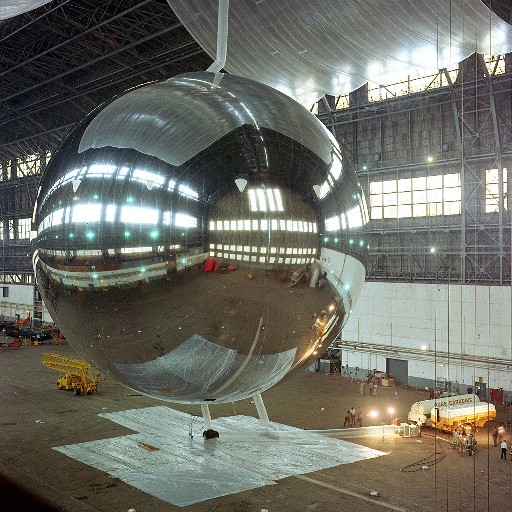ALSACAT-1977-03-17-MULHOUSE-1
The regional newspaper L'Alsace of March 23, 1977, reported a new sighting in the region, headlined "UFOs in the sky of Alsace - The remains of the "Pageos" satellite?
Marcel Brangard, technical agent at Gaz de France, residing in Mulhouse, 175, rue de Bâle, had given them his testimony the day before:
"Waiting for guests, Saturday evening around 8:15 p.m. and going to the window of my apartment I was struck by the luminosity of a sort of star much larger and abnormally located, almost within range eyes, and a twinkle that I would not qualify as orange, but bright white. The object was in the direction of the Vosges. Coming back to the window around 8:30 p.m., I noticed that the shiny object had moved to the right. At 9 p.m. I saw nothing anymore. The star of "first magnitude" had dissolved."
Marcel Brangard had the good idea to get for his camera, he took three shots, and the film was developed in the newspaper's photo laboratory - but the newspaper did not publish them and said nothing about them.
The newspaper then recalled that in its issue of March 20, 1977, "the apparatuses currently observed in Alsace would be, as communicated to us by Mr. Karcher, observer at the Meudon observatory, one of the 80 fragments of the satellite-balloon "Pageos" which was put into orbit in 1966 and which exploded in July 1975. The object currently visible, both day and night, is said to be part of the satellite's nylard [sic, Mylar] envelope. The remaining envelope would spin on itself and the period of revolution would be 178.8 minutes. The passages would last 25 minutes and would be located in the east between 60 and 56 degrees high."
The newspaper added that this explanation, "very plausible, does not satisfy everyone. Some astronomers argue that a satellite having exploded most of the debris would have fallen back to earth and that in any case the extreme brilliance of the object currently observed would tend to invalidate such a thesis. It appears, and most of the declarations collected since Saturday confirm it, that the light given off by this immense star gives the impression of a mirror reflecting the sun.'"
| Date: | March 17, 1977 |
|---|---|
| Time: | 08:15 p.m. |
| Duration: | 15 minutes. |
| First known report date: | March 22, 1977 |
| Reporting delay: | 5 days. |
| Department: | Haut-Rhin |
|---|---|
| City: | Mulhouse |
| Place: | From home window 175 rue de Bâle. |
| Latitude: | 47.750 |
| Longitude: | 7.353 |
| Uncertainty radius: | 10 m. |
| Number of alleged witnesses: | 1 |
|---|---|
| Number of known witnesses: | 1 |
| Number of named witnesses: | 1 |
| Witness(es) ages: | Adult. |
| Witness(es) types: | National Gas co employee. |
| Reporting channel: | The regional Press. |
|---|---|
| Type of location: | From home window in city. |
| Visibility conditions: | Night. |
| UFO observed: | Yes |
| UFO arrival observed: | Yes. |
| UFO departure observed: | No. |
| Entities: | No. |
| Photographs: | Yes. |
| Sketch(s) by witness(es): | No. |
| Sketch(es) approved by witness(es): | No. |
| Witness(es) feelings: | Puzzled. |
| Witnesses interpretation: | ? |
| Hynek: | NL |
|---|---|
| ALSACAT: | Debris of the PAGEOS balloon-satellite. |
[Ref. lae1:] NEWSPAPER "L'ALSACE":

|
UFO here, ufo there. For a few days (is this the wave of the great conference held recently in Mulhouse and which had seen the confrontation of Professor Paul Muller and Jean-Claude Bourret) several witnesses observed in the "south" sky of the region of strange phenomena. In our issue of yesterday March 22, we reported that in Rixheim four people had noticed a very bright red-orange object located approximately in the direction of Masevaux-Thann and which after having remained stationary had suddenly disappeared. The phenomenon was observed between 8:25 p.m. and 9:10 p.m.
Another witness Mr. Marcel Brangard, technical agent at GdF living in Mulhouse, 175, rue de Bâle, visited us yesterday afternoon and, confirming earlier statements, nevertheless provided further clarification.
"Waiting for guests, Saturday evening around 8:15 p.m. and going to the window of my apartment I was struck by the luminosity of a sort of star much larger and abnormally located, almost within range eyes, and a twinkle that I would not qualify as orange, but bright white. The object was in the direction of the Vosges. Coming back to the window around 8:30 p.m., I noticed that the shiny object had moved to the right. At 9 p.m. I saw nothing anymore. The star of "first magnitude" had dissolved."
But Mr. Marcel Brangard had had the presence of mind to look for his camera. He took three pictures. The film produced was developed yesterday at the "L'Alsace" lab.
This document, it goes without saying, will be controversial if not at least debatable. We know from having read it in our previous editions ("L'Alsace" of March 20) that the craft currently observed in Alsace would be, as communicated to us by Mr. Karcher, observer at the Meudon observatory, one of the 80 fragments of the "Pageos" satellite-balloon put into orbit in 1966 and which exploded in July 1975. The object currently visible, both by day and at night, would be part of the envelope of the satellite in nylard [sic, Mylar]. This remaining envelope would spin on itself and the period of revolution would be 178.8 minutes. The crossings would last 25 minutes and be located to the east between 60 and 56 degrees high.
This explanation, very plausible, does not satisfy everyone. Some astronomers argue that a satellite having exploded most of the debris would have fallen back to earth and that in any case the extreme brightness of the object currently observed would tend to invalidate such a thesis. It appears, in fact, and most of the statements collected since Saturday confirm it, that the clarity given off by this immense star gives the impression "of a mirror reflecting the sun."
[Ref. aldl:] MRS. GUEUDELOT, "LUMIERES DANS LA NUIT" ARCHIVE:

|
MARCH 19, 1977.-
MULHOUSE. - (68)
Time: 8:15 p.m.
Mr. BRANGARD, 175, rue de Bâle in MULHOUSE confirms the observation in the sky of Mulhouse, of a phenomenon observed since 8:15 p.m. The person concerned took three black and white photos with a 200 mm telephoto lens.
The person concerned presented himself to the newspaper "L'ALSACE" on Tuesday MARCH 22, gave the film to the newspaper which developed it. A photo was published in the newspaper on Wednesday MARCH 23, 1977.
Press. SENT BY M. PERNOT.
[Ref. cnu1:] UFOLOGY GROUP "CNEGU":

|
Ref. F/00/68/77 03 19 (01)
Saturday March 19, around 8.15 p.m. (UTC 7.15 p.m.) a resident of Mulhouse (68) saw a very large star near the Vosges from his home. He takes 3 shots of the fixed phenomenon before it disappears at 9 p.m.
Explanation: fragments of the "PAGEOS" satellite visible to the East between 60 and 56° high, which would have exploded in 1975, source: Meudon observatory.
Source: newspaper l'"Alsace" for 23/03/77 ("UFOLOGIA" nr 9 p. 6).

|
PAGEOS (PAssive Geodetic Earth Orbiting Satellite) was a geodetic balloon-satellite, launched by NASA in June 1966, set up to form a global triangulation network with accuracy of 3 to 5 meters.

|
The balloon had a diameter of 30 meters and was made of Mylar (the very solid "plastic" of the "chips" bags), aluminized, with a metallic-looking and highly reflective surface.
PAGEOS was placed in a polar orbit at a height of about 4000 km, which had gradually diminished over its 9 years of use, finally partially disintegrating in July 1975, with a second break-up in January 1976, which resulted in the release of a large number of fragments, most of which re-entered the atmosphere, slowly, over the next decade.
Just a look at the PAGEOS photo I show above is enough to realize that the "few astronomers" who argued according to L'Alsace that "the extreme brilliance of the object currently observed would tend to invalidate" that it would be PAGEOS debris because the things gave "the impression of a mirror reflecting the sun" were wrong. The envelope is obviously precisely like a mirror reflecting the sun. When they argued "that a satellite having exploded most of the debris would have fallen back to earth", they simply did not understand that it was not a satellite but a satellite-balloon.
Finally, on November 5, 1990, there was a "UFO" seen from the South-West to the North-East of France by a multitude of people; which was in fact debris from a Russian rocket. Among those who observed and correctly identified what was happening were "Daniel Karcher, amateur astronomer from Wittenheim"; it may be the same Mr. Karcher mentioned by the newspaper in this case.
For the record, the predecessors of PAGEOS were Echo 1 (1960) and Echo 2 (1964), the astronomer and ufologist J. Allen Hynek having participated in the Echo 2 program.
Other cases in the region with the same explanation:
Debris of the PAGEOS balloon-satellite.
* = Source is available to me.
? = Source I am told about but could not get so far. Help needed.
| Main author: | Patrick Gross |
|---|---|
| Contributors: | None |
| Reviewers: | None |
| Editor: | Patrick Gross |
| Version: | Create/changed by: | Date: | Description: |
|---|---|---|---|
| 0.1 | Patrick Gross | August 20, 2022 | Creation, [lae1]. |
| 1.0 | Patrick Gross | August 20, 2022 | First published. |
| 1.1 | Patrick Gross | January 19, 2023 | Addition [cnu1]. |
| 1.2 | Patrick Gross | September 10, 2023 | Addition [ald1]. |